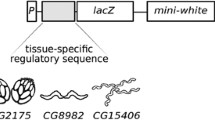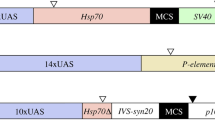Summary
Drosophila melanogaster flies were transformed with a yp1-Adh fusion gene with 890 bp of yp1 5′ flanking sequence. In an Adh - background these flies show a stage, tissue and sex-specific pattern of alcohol dehydrogenase (ADH) activity characteristic of yolk protein genes. ADH activity is not present in dsx D/dsx pseudomales indicating that this fragment contains sites where the dsx gene product exerts its effect. Transformed male flies do not exhibit ADH activity when injected with 20-hydroxyecdysone while synthesis of native yolk proteins is induced. Thus the hormone inducibility and sex regulation have been separated in this construct.
Similar content being viewed by others
References
Barnett T, Pachl C, Gergen JP, Wensink PC (1980) The isolation and characterisation of Drosophila yolk protein genes. Cell 21:729–738
Belote JM, Handler AM, Wolfner MF, Livak KJ, Baker BS (1985) Sex-specific regulation of yolk protein gene expression in Drosophila. Cell 40:339–348
Bonner JJ, Parks C, Parker-Thornburg J, Martin MA, Pelham HRB (1984) The use of promoter fusions in Drosophila genetics: isolation of mutations affecting the heat shock response. Cell 37:979–991
Bownes M, Blair M (1986) The effects of a sugar diet and hormones on the expression of the Drosophila yolk-protein genes. J Insect Physiol 32:493–501
Bownes M, Hames BD (1978) Analysis of yolk proteins in Drosophila melanogaster. FEBS Lett 96:327–330
Bownes M, Nöthiger R (1981) Sex-determining genes and vitellogenin synthesis in Drosophila melanogaster. Mol Gen Genet 182:222–228
Bownes M, Blair M, Kozma R, Dempster M (1983) 20-hydroxyecdysone stimulates tissue-specific yolk-protein gene transcription in both male and female Drosophila. J Embryol Exp Morphol 78:249–268
Brennan MD, Weiner AJ, Goralski TJ, Mahowald AP (1982) The follicle cells are a major site of vitellogenin synthesis in Drosophila melanogaster. Devel Biol 89:225–236
Brown DM, Frampton J, Goelet P, Karn J (1982) Sensitive detection of RNA using strand-specific M13 probes. Gene 20:139–144
Garabedian MS, Hung M-C, Wensink PC (1985) Independent control elements that determine yolk protein gene expression in alternative tissues. Proc Natl Acad Sci USA 82:1396–1400
Garabedian MJ, Shepherd BM, Wensink PC (1986) A tissue-specific enhancer from the Drosophila yolk protein 1 gene. Cell 45:859–867
Garabedian MJ, Shirras AD, Bownes M, Wensink PC (1987) The nucleotide sequence of the gene coding for Drosophila melanogaster yolk protein 3. Gene 55:1–8
Hovemann B, Galler R, Walldorf U, Kupper H, Bautz EK (1981) Vitellogenin in Drosophila melanogaster: sequence of the yolk protein I gene and its flanking regions. Nucleic Acids Res 9:4721–4734
Hung M-C, Wensink PC (1981) The sequence of the Drosophila melanogaster gene for yolk protein 1. Nucleic Acids Res 9:4721–4734
Hung M-C, Wensink PC (1983) Sequence and structure conservation in yolk proteins and their genes. J Mol Biol 164:481–492
Hung M-C, Barnett T, Woolford C, Wensink PC (1982) Transcript maps of the Drosophila yolk protein genes. J Mol Biol 154:581–602
Jowett T, Postlethwait J (1980) The regulation of yolk polypeptide synthesis in Drosophila ovaries and fat bodies by 20-hydroxyecdysone and a juvenile hormone analogue. Dev Biol 80:225–234
Maniatis T, Fritsch EF, Sambrook J (1982) Molecular Cloning. A laboratory manual. Cold Spring Harbor Laboratory, Cold Spring Harbor, New York
Nöthiger R, Steinmann-Zwicky M (1985) Sex-determination in Drosophila. Trends Genet 1:209–215
Postlethwait JH, Bownes M, Jowett T (1980) Sexual phenotype and vitellogenin synthesis in Drosophila melanogaster. Dev Biol 79:379–387
Rubin GM, Spradling AC (1983) Vectors for P element-mediated gene transfer in Drosophila. Nucleic Acids Res 11:6341–6351
Steller H, Pirrotta V (1985) A transposable P vector that confers selectable G418 resistance to Drosophila larvae. EMBO J 4:167–171
Author information
Authors and Affiliations
Additional information
Communicated by K. Illmensee
Rights and permissions
About this article
Cite this article
Shirras, A.D., Bownes, M. Separate DNA sequences are required for normal female and ecdysone-induced male expression of Drosophila melanogaster yolk protein 1. Mol Gen Genet 210, 153–155 (1987). https://doi.org/10.1007/BF00337772
Received:
Issue Date:
DOI: https://doi.org/10.1007/BF00337772




